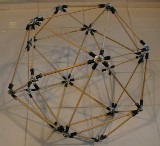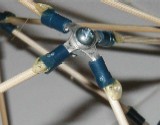


There's no substitute for a physical model you can hold in your hands, particularly for things where not all the angles are nice and square. Here's some photos of a geodesic sphere, based on a octahedron (so it has symmetry around 3 orthogonal planes, handy for attaching cables, etc.). The radius of this sphere is 15 cm, making the longer struts 15 cm, and the shorter struts 11.6 cm. The struts are fabricated from bamboo skewers and ring lugs epoxied to their ends. Detail photos of the 4 edge and 6 edge vertices show how the ring lugs are just bolted together with machine screws. All the photos are clickable for a higher resolution version. For scale, the tiles on the counter under the model are 4" (20cm) on a side,
There are two kinds of faces on this sphere. One is an equilateral triangle with long sides. (Long means the longer of the two edge lengths, i.e. equal to the sphere radius.) The other is an isoceles triangle with 2 short sides and one long side. When rolling from an equilateral face, the shape is symmetric around the face, so tipping/rolling it onto an adjacent face is the same in all directions. It's always towards a "4 edge" vertex.
|
The photo below shows a vertical view down on the base triangle and the three directions that it can tip. |
The photo below shows a side view of the bottom of the geodesic. The arrow indcates how it will tip onto an adjacent face, and the dashed line is the fulcrum about which it rotates as it tips. |
The other face of the sphere is an isoceles triangle with two short sides and one long one. Again, there are 3 possible tip directions, but one is much more favorable than the other two. The tip towards the equilateral is easier (the CG of the sphere is closer to the long side of the triangle. The other two tips are towards the adjacent isosceles triangles.
|
Here's the tip towards the equilateral (essentially the opposite of the tip shown above). Note that the CG of the sphere is almost directly above the pivot line. |
Here's the tip towards the adjacent isoceles triangles. |
robot/sphere1.htm - 5 Nov 2002 - Jim Lux
(robot main page) (Jim's
home page)